
All Solutions

Explore all the solutions you can create with Paperform: surveys, quizzes, tests, payment forms, scheduling forms, and a whole lot more.
See all solutions











Connect with over 2,000 popular apps and software to improve productivity and automate workflows
See all integrationsProducts
Solutions
All Solutions

Explore all the solutions you can create with Paperform: surveys, quizzes, tests, payment forms, scheduling forms, and a whole lot more.
See all solutionsIntegrations

Connect with over 2,000 popular apps and software to improve productivity and automate workflows
See all integrationsResources
How To Start an Online Fitness Business

More and more people are opting for at home workouts over heading to a brick and mortar gym. And while the online, on-demand fitness model might seem like a relatively new phenomenon, research shows that the switch to virtual and at-home workouts has been brewing for several years. There’s been steady growth in the online fitness sector, and there are reasons to believe it’s only going to increase.
With that in mind, if you’re looking to start a fitness business, you need to make sure your business plan can thrive in online, too. In this article, we’ll go over how to create a successful online fitness business step by step, so you can ride the wave of people leaving the gyms and hitting the living room.
What is an online fitness business?
An online fitness business can look like a myriad of things, but all of them will offer a way for people to get exercise via online tools and classes. You could offer virtual training to groups of students or help individual clients with their wellness goals by running an online personal training business.
Most online fitness businesses offer workout videos and virtual classes that are either live or recorded using online coaching platforms, though some branch out into training services, tutorials, or weight-loss and wellness plans.
Why start an online fitness business?
It seems like every personal trainer and fitness professional is leveraging their social media platforms to promote an online coaching business. And why wouldn’t they? There's a huge demographic of folks who don’t feel comfortable being in a gym, but are still looking to keep up their fitness.
In fact, 72% of consumers say they prefer an online fitness option to going to a brick and mortar gym. Plus, starting an online fitness business can help you expand without the sunk costs of setting up a bricks-and-mortar gym. Still not completely convinced? Here's some more data:
- A 2020 study by ClubIntel tells us that “84% of Gen Z reported their facility offered digital fitness content, 25 to 30 percentage points higher than the other generations."
- By 2027, the market for online and virtual fitness is estimated to be valued at $59 billion.
- According to Uscreen’s data, trainers with online fitness studios earn an average of $7,503 per month.
There’s clearly demand for online fitness classes, and there’s room in the market for new growth. If you’re interested in starting your own fitness business, now may be the time to do it.
But before you start, it’s a good idea to get a sense of what kinds of online exercise classes are already out there.
gym membership form
Two main types of online fitness businesses
When you look at the market for online health and fitness classes, you'll recognize two models being used: fully virtual or hybrid. Each option has its pros and cons. We’ll break them down to give you a rounded view of how you can start your online classes.
Fully-virtual model
Going fully virtual with your online fitness business means you'll forgo any physical presence and be wholly online.
If you’re looking for work as a trainer but you’re not interested in being in a gym in person, you might opt for fully virtual online personal training.
Pros of going fully virtual:
- Your customers can access your classes wherever and whenever they want.
- Business overheads are low– you don't need to invest in gym equipment or rent a large space to run classes.
- Your total addressable market isn't limited by constraints such as location or language– people from all over the world can buy your training programs.
- You can create and share your content on your own schedule.
Cons of going fully virtual:
- It’s less personal. Clients and customers may feel distant, and you can't personally monitor training goals as accurately.
- You’ll need a basic understanding of data and computers in order to optimize your business.
- Posture corrections and in-class injuries or strains can't be directly attended to in the moment, as they would in person.
training evaluation form
Hybrid model
In contrast to going fully virtual, a hybrid model gives your customers the option to work out online or in-person.
A hybrid model is great for those trainers who already have in-person clients, and are looking to expand their reach online without losing them.
Pros of the hybrid model:
- More personal– your clients have the option to work out with you in person, and still take classes when they're traveling or can't get to your location.
- You have in person connections from your clients which can help you market your online classes or get referrals, testimonials, or even brand reps.
- Adding an additional revenue stream to a pre-existing business is less risky.
Cons of the hybrid model:
- Focus is split between your online and offline classes, which means you could end up spreading yourself too thin.
- Running an online business needs some skills you may not already have as an in-person trainer.
- If you're setting up a hybrid model from scratch, you’ll need more start up money to find a brick and mortar location in addition to building your online business.
Form a better life now.
Three pricing models for your online fitness business
Picking the right pricing model will help you make the profit you deserve, and keep your customers happy. There are three main options: the subscription, multi-tiered subscription, or transactional models.
Choosing a pricing model will come down to the unique value you offer, your target audience, and the time you have to create content.
Subscription model
A subscription service has members pay a monthly or yearly fee for access to your online fitness classes. It gives the business owner a stable income, and your customers know exactly what they pay, and what they’re getting.
This popular model will require you to add content regularly so that your long-term members don't get bored with the same videos.
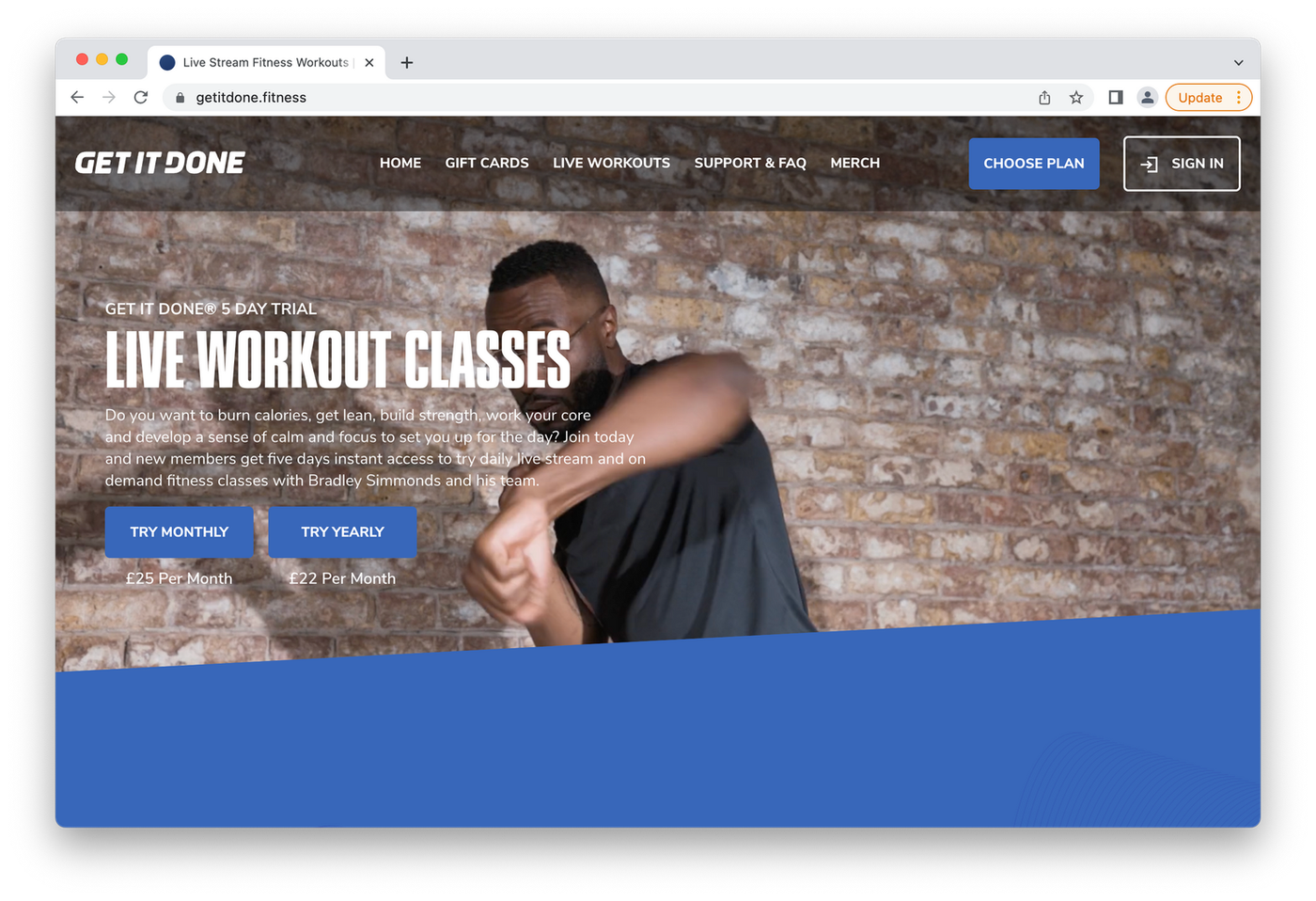 (Image Source: Get It Done)
(Image Source: Get It Done)Get It Done Fitness runs a subscription model, and offers live and on-demand fitness content for its subscribers.
The site is run by trainer Bradley Simmonds and his team. They offer regular live stream classes, so there’s always fresh content for members to access. Since the videos only remain on the site for a week, members have a reason to return often.
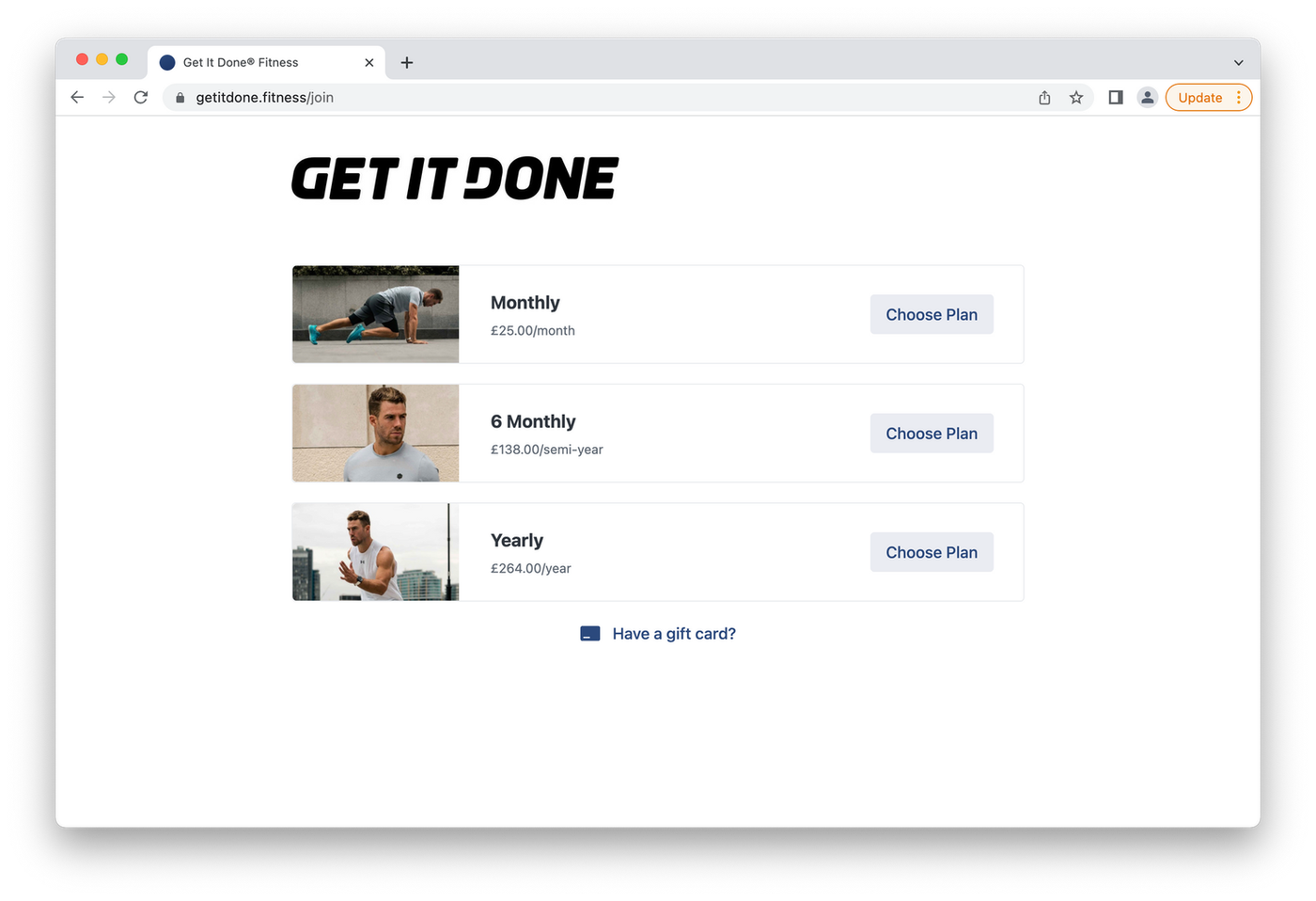 (Image Source: Get It Done)
(Image Source: Get It Done)This business has chosen to offer discounts for customers who sign on for a longer membership, a common pricing strategy in the fitness industry. Along with lower prices for a longer commitment, customers can get an added perk of a personal message from their online personal trainer, which can help keep clients engaged and boost customer retention.
Multi-tiered subscription model
Multi-tiered subscriptions are the more advanced version of a basic subscription model. They're a chance for you to offer extra layers of value to your customers through premium features, which can include things like:
- Longer or earlier access to classes
- Exclusive access to your live stream classes
- Use of the mobile, TV, and Apple Watch app you set up
As with normal subscriptions, you'll need to release new content often. There's an added challenge of maintaining different feature levels, but by adding these tiers, you can better engaging your users by offering them more premium options.
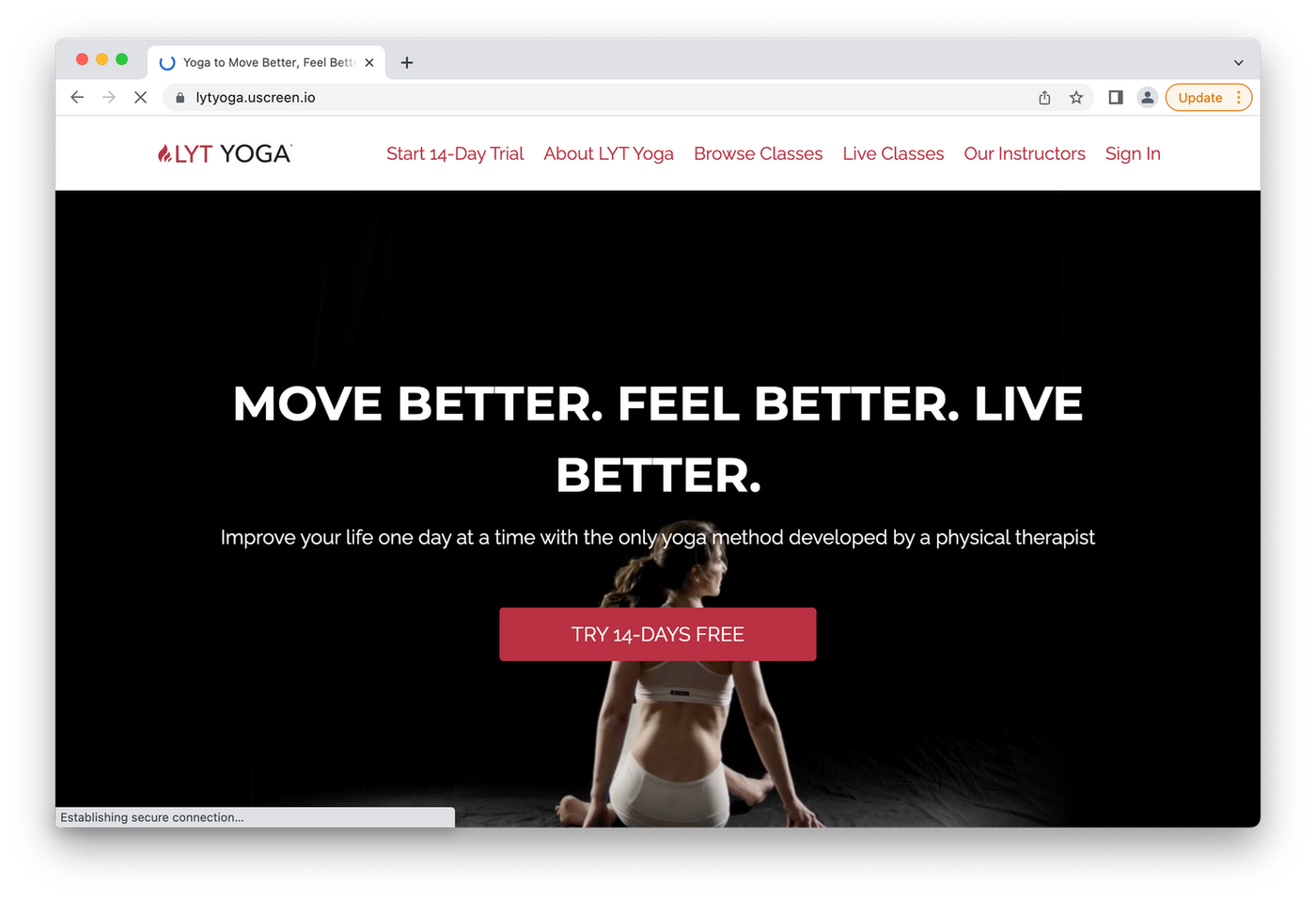 (Image Source: LYT Yoga)
(Image Source: LYT Yoga)LYT Yoga uses a multi-tiered subscription model. LYT Yoga offers 3 different pricing tiers, each one with different benefits so members can choose the price and perks that work for them and their fitness goals.
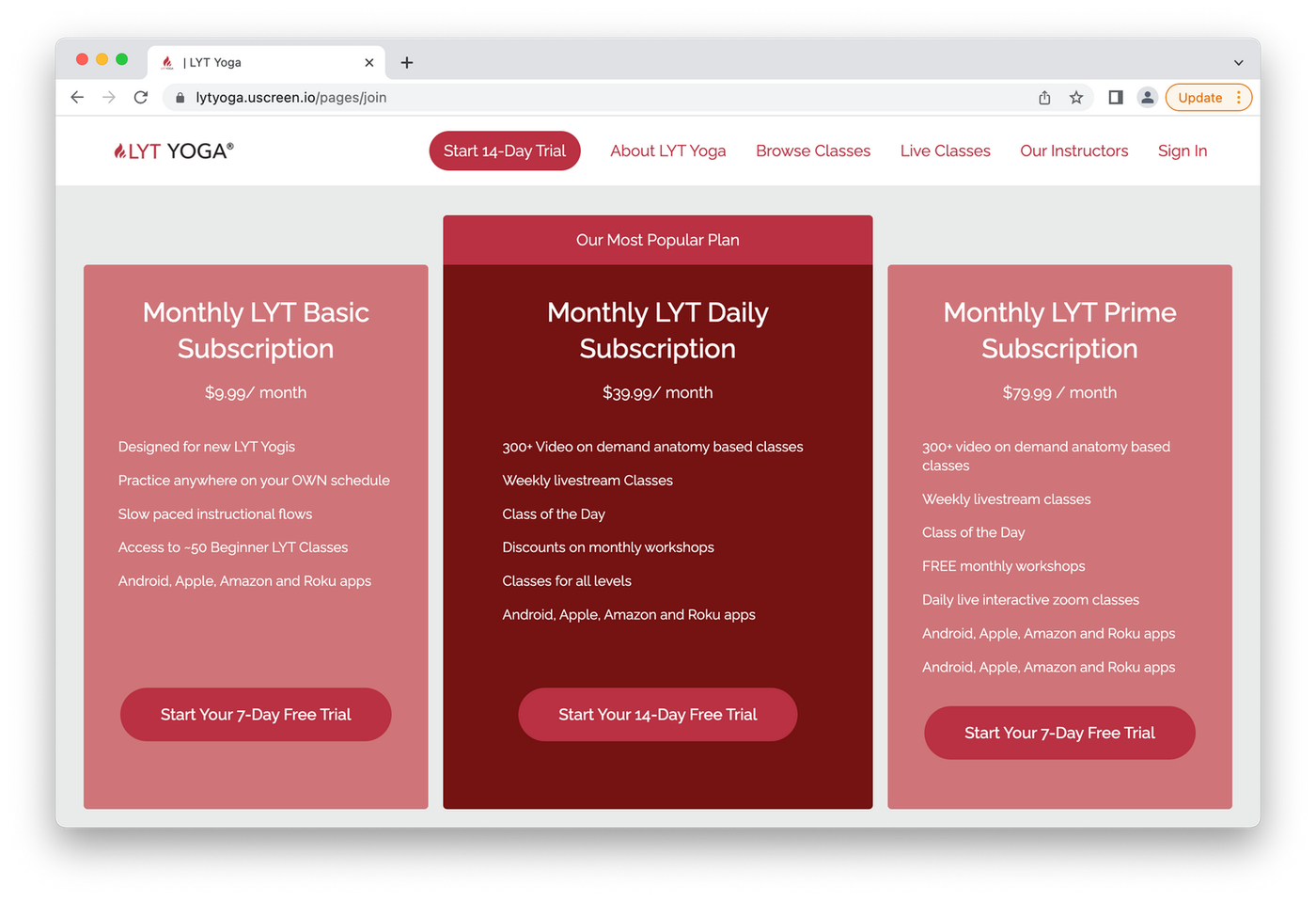 (Image Source: LYT Yoga)
(Image Source: LYT Yoga)As well as increasing accessibility across income levels, it also gives LYT extra tools to boost income and reduce churn. Giving customers options to bump up or down can increase the likelihood that clients will simply alter if they need a change, rather than ditch your business all together.
Transactional model
If you've ever watched a sporting event on pay-per-view, you'll be familiar with the transactional pricing model. Rather than asking for a recurring payment from your customers, with this model, you sell individual classes or packages of classes for a one-time fee.
In terms of online fitness classes, this method tends to work best when teaching a skill, such as "boxercise 101" or "the complete course for dancing Thriller." You could also think of it like you’re selling a bundle of training sessions, like you’d do in an in-person gym, in the hopes that your online clients will buy another bundle once they’ve used them up.
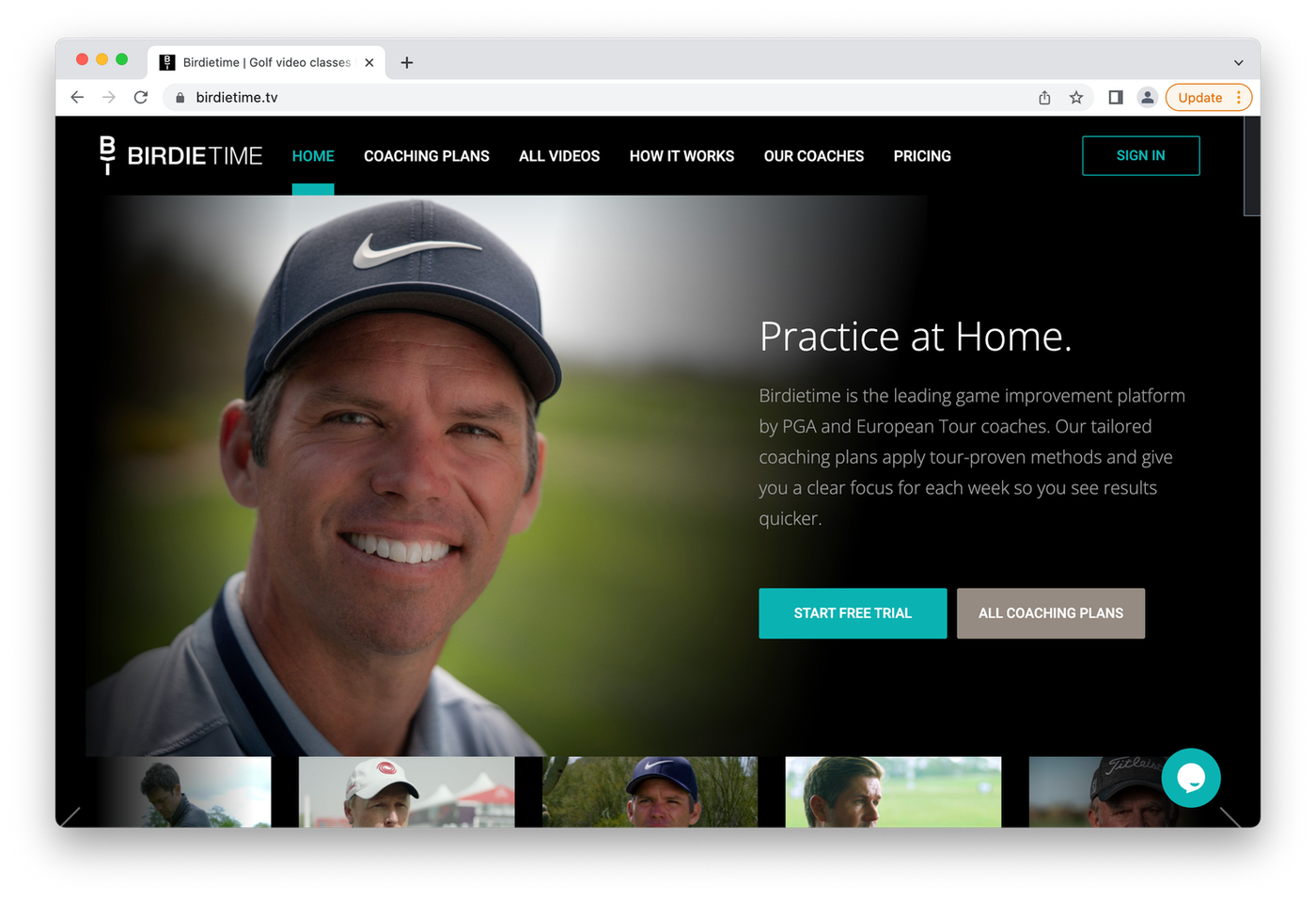 (Image Source: Birdietime)
(Image Source: Birdietime)Birdietime uses a transactional model. They offer online golfing classes from some of the best coaches in the world. You can join as a subscriber and get access to the classes, or you can use the single coaching plan. The transactional model is at work in their single coaching plans, which can be bought for a one-off fee.
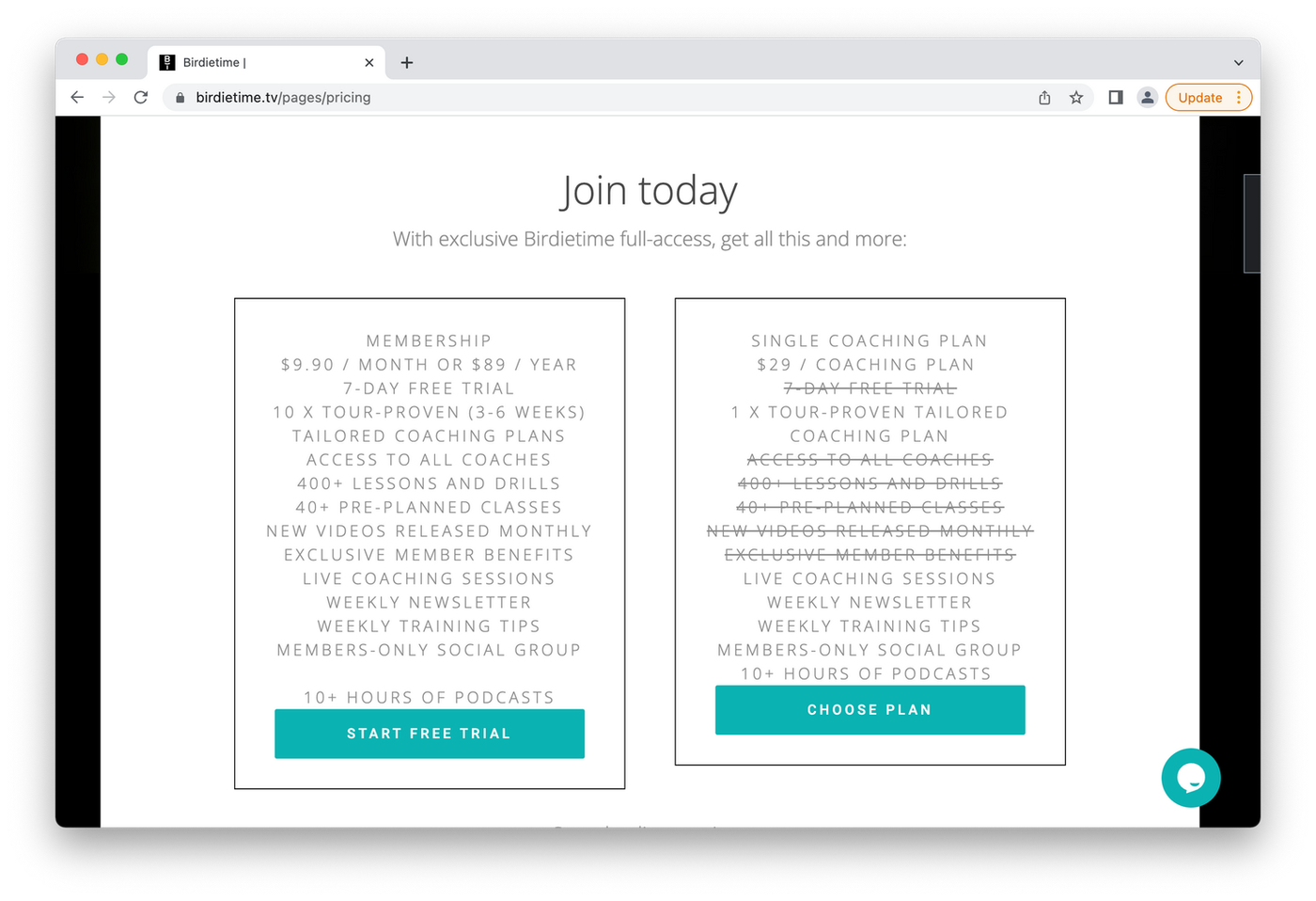 (Image Source: Birdietime)
(Image Source: Birdietime)The lifetime value (LTV) of a customer is lower using the transactional pricing model, but it can work as a stepping stone to subscriptions and still offers great value to your customers.
How to start an online fitness business in 4 steps
Now that you’re familiar with the business and pricing models, it’s time to get into the details of how to create and grow your own online fitness business.
Starting your fitness business can be broken down into four steps:
- Choosing your business and pricing model
- Creating content
- Building a site
- Promoting your business
Choose the type and pricing model of your business
The first thing you’ll need to do to start your online fitness business is to decide what type of classes or skills you can offer. As you can imagine, marketing yourself as a dance teacher will look a lot different than marketing yourself as a HIIT trainer. The type of classes you’ll teach will also inform whether you go with a fully-virtual or hybrid model.
Once you’ve decided what type of fitness training you’ll do, you’ll need to pick a pricing model. You can decide which one will work best for you based on the information in the previous section.
There are pros and cons for the subscription, multi-tiered subscription, and transactional models, so prioritise your business's unique needs over anything else.
Other factors that'll go into choosing your pricing model will include your revenue goals, what your competition is doing, how you plan to market your business, and other monetisation options like selling fitness equipment or workout gear.
Create the content for your online fitness business
After working out the finances, it's time to get on the mat and start making content. How you start is going to depend on your audience - are you targeting people at the start of their fitness journey and need to lay out the absolute basics, or do you want to offer HIIT classes for seasoned practitioners?
Regardless of what it is, you need to have enough content ready when you launch to wow your clients and keep them coming back.
Before you get going, think about how you want your content to stand out. You can do this by researching the content your competitors offer. Try to understand what your audience is looking for. Once you’ve done that, you can create a few core categories, get some solid content made, and create a plan for how it'll develop into the future.
Launch your site
A vital component of your online fitness business is your website. Without a way to host your classes, your customers can’t enjoy them. Even if you've already got a website for your existing gym, a video-focused membership site can change the game.
When deciding where to host your business, you can choose one of two paths:
Build your own membership site: This will likely require a website developer and multiple subscriptions, but may give you more creative freedom.
Use a membership site platform: Platforms like Uscreen are designed to get your business up and running quickly and easily, sometimes at the expense of total creative freedom.
Promote your online fitness program
With your site ready to go, you’re ready to find your audience and promote your new online fitness business. There are lots of ways you can market your new website, but we’ve highlighted a few tried and true methods.
- Harness the power of your existing social media, like Instagram and YouTube, to direct your followers to your new site.
- Email your current list of subscribers (if you have one) and offer a special deal or discount for signing up to your site.
- Start to understand your audience and use paid advertising on the channels your audience uses to reach people who will want to take your classes.
- Offer content in innovative ways, such as podcasts, long-form blog content, or quick exercises on TikTok to get your brand name in front of potential customers.
Marketing is a skill in itself. There are techniques that you can pick up when you're starting out, or you could hire someone to market your business for you. Every fitness business is unique, so you’ll need to find the marketing strategy that helps you find new clients. That might be digital marketing, word of mouth, social media marketing, or something totally different.
Over to you
Whether you've got an in-person presence as a trainer already, or you’re looking to start an online only fitness business, there's a business model and pricing structure that can help you succeed. By going through the steps outlined in this article (and doing a bit of learning on the fly) you’ll be on your way to teaching online in no time.
Like starting any small business, launching an online fitness business will require research, patience, and hard work. But, you can also expect to have a bit of fun in the process. Whatever the challenges you face, remember that there is a market for what you're doing, and loads of tools to help you do it.
This guest post was written by Amir Shazeidi, SEO Lead at Uscreen, a robust video monetization and distribution platform.
Form a better life now.
Get your 7 day unrestricted trialHere is the ultimate list of online form builders, what they do best, their pricing, and examples to...
Independent retailers are some of the smartest operators in small business—but they’re forced to wor...
Independent retailers are some of the smartest operators in small business—but they’re forced to wor...
The ultimate list of Black Friday and Cyber Monday SaaS deals for 2025